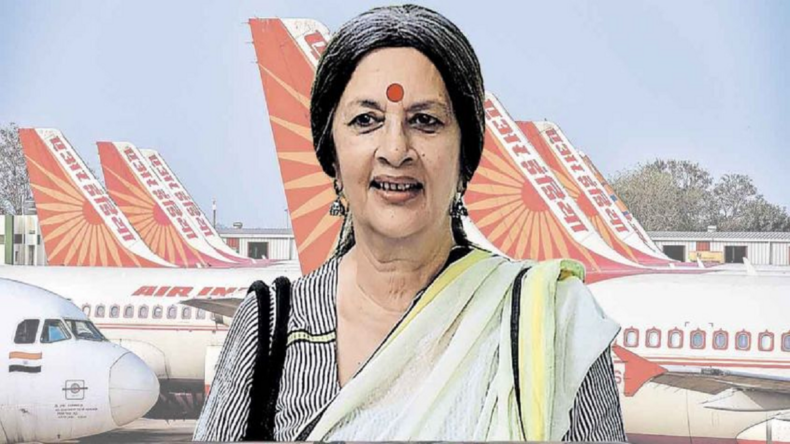Air India, the national carrier, has been the scene of several strikes; the lone struggle that took place 54 years ago was different from all of them. The strike that made Air India wear a sari turned into a strike when it went sari. Strike to wear a sari at an airport on British soil.
Fifty-four years ago, the three-week-long one-person strike ended with a letter from India. Alan, Air India Manager, London Heathrow Airport, said: ‘Brinda Das, you have succeeded. Anyone can wear a sari here on Air India, not just you. ‘
“Sari nationalism,” Brinda said. Employees of Air India, the national carrier, have the right to wear Indian clothing that it is his right to be an Indian. “I agreed with the other clothes.
I objected when Air India suggested that women wear skirts and coats if they wanted to work in London. As an Indian, why shouldn’t I wear my national sari? I struggled to go to work wearing a sari every day. No one is with me. I could not fire for fighting for the sari. ”
Allen recently wrote to Bobby Cooke, then Air India’s commercial director, saying that a young woman from Kolkata insisted on wearing a sari. Bobby and artist Umesh Rao dressed up as the Maharaja of Air India and played various roles.
Bobby, who created the Maharaja with a mustache that stretches across the borders of his face to the sides, cannot oppose the six-inch dress.
Bobby replied to Alan: ‘Air India is India’s national carrier. Its employees abroad are representatives of India itself. Indian clothing is part of Indian nationalism. Therefore, not only Indians but also foreigners working in Air India can wear Indian clothes. ‘
After reading the last sentence, Alan said to Brinda: ‘My problem is over. Now you have a problem. ‘Selection of British young women demanding to teach to wear a sari. So, Brinda dressed the British in a sari.
After graduation, her father, Suraj Lal Das, told her daughter to stand on her own two feet, so Brinda got a job at Air India. There he struggled to stand on his sari.
From 1967 to 1970, Brinda worked for Air India. After resigning, he returned to Kolkata and joined the CPM. That group is now a member of the CPM Politburo, Brinda Karat. Wife of former CPM general secretary Prakash Karat. From the small skirt size profit.
Air India, which has suffered a saree-long loss, will fly in the Tata shirt.
Brinda was born in Kolkata and spent four childhoods with her family, including one brother and three sisters. His father’s name was Suraj Lal Das. By the age of five, Brinda had lost her mother, Oshukona Mitra. His sister Radhika Roy is married to Pranoy Roy.
She completed her primary education at Welham Girls School in Dehradun. At 16, he graduated with a BA from a college affiliated with the University of Darhi, Mirinda House.
Brinda Karat (October 17, 1947) was a Communist politician in India. As the CPI (M)’s representative, she has been elected to the Rajya Sabha from West Bengal since April 11, 2005, as CPI (M) ‘s representative.
In 2005, Brinda Karat became the first woman elected to the CPI (M) Politburo. She was the General Secretary of the All-India Democratic Women’s Association from 1993 to 2004 and is currently its Vice President. Former CPI (M) Brinda is the wife of General Secretary Prakash Karat.
Tata shares outperform Air India
These are the days of Tata in the stock market. Tata Motors Tata Motors’ leap has benefited the entire automobile sector. Several positive news from the Tata family, including the acquisition of Tata Air India, has attracted many investors to Tata stocks. With just three hours left in business last Wednesday.
Shares of Tata Motors saw a significant increase in value over the amount acquired by Air India. Last week, Tata acquired Air India for Rs 18,000 crore. So far this month, the market capitalization of Tata shares has risen by over Rs 1 lakh crore.
Tata Motors will acquire a 100 percent stake in Air India and Air India Express and a 50 percent stake in Air India Airport Services Pvt. Shares of Tata Motors have been performing brilliantly for the past two weeks.
Fortress and gain
Currently, Tata has many benefits when it acquires Air India. Excellent brand. Best slots at all major airports, and that too at Heathrow in London and John F. Kennedy Airport in New York.
The best pilots. Large aircraft of this type are required to fly long distances. And the feel of the Indian brand.
There are many disadvantages – the whole thing needs to change. Even the upholstery of the seats needs to be replaced. Flights do not have Wi-Fi. Entertainment
Events are terrible. Contracts that incur huge costs.
What now?
The plan to revive Air India is ready in 2019 itself. All existing directors will change, and new ones will come. The new MD will come. Tata Sons Chairman N Chandrasekaran has said that Air Asia, Vistara, and Air India cannot be run by three airlines.
Not in the old days; other airlines were far ahead in services and aircraft. Surviving all that and elevating Air India is a Himalayan endeavor












